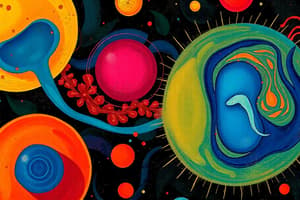Podcast
Questions and Answers
Where does sperm production primarily occur in the male reproductive system?
Where does sperm production primarily occur in the male reproductive system?
- Seminal vesicles
- Prostate
- Epididymis (correct)
- Vas deferens
In the female reproductive system, where does the egg journey to potentially meet a sperm cell for fertilization?
In the female reproductive system, where does the egg journey to potentially meet a sperm cell for fertilization?
- Ovary
- Uterus
- Fallopian tubes (correct)
- Cervix
Which male gland secretes fluid that mixes with sperm to form semen?
Which male gland secretes fluid that mixes with sperm to form semen?
- Prostate
- Epididymis
- Seminal vesicles (correct)
- Vas deferens
What is the primary organ involved in egg cell development in the female reproductive system?
What is the primary organ involved in egg cell development in the female reproductive system?
During which stage of the menstrual cycle is the egg released from the ovary?
During which stage of the menstrual cycle is the egg released from the ovary?
Where does sperm exit the male body during sexual intercourse?
Where does sperm exit the male body during sexual intercourse?
What is the first phase of the menstrual cycle?
What is the first phase of the menstrual cycle?
During which phase of the menstrual cycle does ovulation occur?
During which phase of the menstrual cycle does ovulation occur?
What is the term for the fusion of an egg and a sperm cell?
What is the term for the fusion of an egg and a sperm cell?
Where does the zygote implant itself if fertilization occurs?
Where does the zygote implant itself if fertilization occurs?
What happens once a sperm cell penetrates the egg's protective outer layer?
What happens once a sperm cell penetrates the egg's protective outer layer?
At what point does a zygote develop into an embryo?
At what point does a zygote develop into an embryo?
Flashcards are hidden until you start studying
Study Notes
Reproduction in Humans
Reproduction is a fundamental aspect of human biology, allowing individuals to pass their genetic material to future generations. It involves two main processes — gametogenesis and fertilization — which occur within specialized organs called gonads. In humans, these gonads are found only in adults; in males they're known as testes, while in females they're called ovaries. Both systems work together to produce viable offspring. This article will explore the different elements of reproduction in humans, including the male and female reproductive systems, the menstrual cycle, pregnancy stages, and the fertilization process.
Male Reproductive System
The male reproductive system primarily consists of the testes, where sperm production occurs through a process called spermatogenesis. Sperm matures in the epididymis before it can enter the vas deferens. From there, sperm travels into the ejaculatory ducts, along with fluid from the seminal vesicles and prostate, until it exits the body during sexual intercourse.
Female Reproductive System
In contrast, the female reproductive system revolves around the ovary, where egg cells develop through a process called oogenesis. After reaching full development, the egg is released by the ovary during a woman's monthly menstrual cycle. Once released, the egg journey to the uterus via the fallopian tubes, where it may potentially meet a sperm cell for fertilization.
Menstrual Cycle
The menstrual cycle refers to the phases a woman's body undergoes each month in preparation for possible fertilization. These phases consist of the follicular phase, ovulation phase, and luteal phase. During the follicular phase, hormones stimulate the growth of several eggs inside the ovaries. About halfway through this phase, one egg becomes dominant, causing the other eggs to either dissolve or remain dormant. At ovulation, the most mature egg is released from its follicle and enters the fallopian tube, ready to be fertilized.
Pregnancy Stages
If fertilization does occur, the zygote formed from the fusion of an egg and sperm cell travels down the fallopian tube towards the uterus. There, it implants itself into the endometrium, initiating the first stage of pregnancy, known as implantation. As the embryo grows, it consumes nutrients from the mother's bloodstream, developing into a fetus over the next few months. By week nine, the fetus has grown enough to have all major organ systems functioning. The second half of the gestational period sees a rapid growth spurt for the fetus, culminating in birth, which marks the beginning of the third stage of postpartum life.
Fertilization Process
Fertilization is the joining of a sperm cell to an egg cell. For fertilization to occur, sperm must travel through the cervix, uterus, and fallopian tubes to reach the egg. When a sperm cell reaches the egg, its membrane binds to specific proteins found on the surface of the egg, triggering the acrosome reaction that allows the sperm to penetrate the egg's protective outer layer, the zona pellucida. Once inside the egg, the sperm releases its nucleus, forming a new entity called the zygote. This zygote continues to divide, eventually developing into an embryo.
Studying That Suits You
Use AI to generate personalized quizzes and flashcards to suit your learning preferences.




